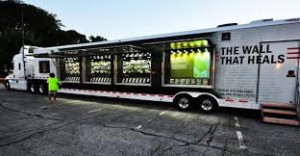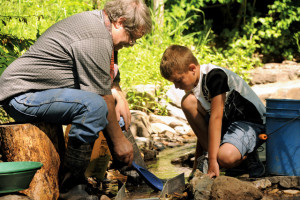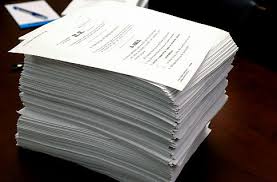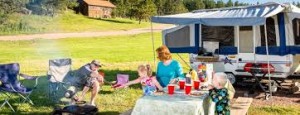
The Wall That Heals, a 250-foot replica of the Vietnam Veterans Memorial, along with a mobile Education Center, is coming to Chamberlain on Aug. 10-13 at the I-90 Information Center/Rest Area (Exit 264) and will be open 24 hours a day and free to the public. The Wall That Heals honors the more than three million Americans who served in the U.S. Armed forces in the Vietnam War and it bears the names of the more than 58,000 men and women who made the ultimate sacrifice in Vietnam.
The Vietnam Veterans Memorial is one of the most visited memorials in our nation’s capital, with more than 5.6 million visitors each year. However, many Americans have not been able to visit what has become known to many as “The Wall.” The Vietnam Veterans Memorial Fund (VVMF), the organization that built The Wall in 1982, wants to give all veterans and their family members all across America an opportunity to see the Memorial.
“Taking The Wall That Heals on the road gives thousands more veterans and their family members an opportunity to see The Wall and honor those who have served and sacrificed so much,” said Jim Knotts, president and CEO of VVMF. “It helps veterans from all of America’s conflicts to find healing and a powerful connection through their common military experiences.”
South Dakota Public Broadcasting has arranged for The Wall That Heals to be conveniently located at the rest area off I-90 at Chamberlain near the Dignity sculpture. The exhibit is a part of SDPB’s statewide outreach effort to honor veterans from the Vietnam era, Gold Star families, and others affected by the Vietnam War. This effort is in advance of the premiere of The Vietnam War, a new film by Ken Burns and Lynn Novick, premiering this fall on SDPB and PBS stations nationwide.
“South Dakota has a long tradition of honoring its veterans and others involved in war. Being able to bring The Wall That Heals to South Dakota is a thrill and an honor for South Dakota Public Broadcasting,” said Julie Overgaard, Executive Director of SDPB. “We’re grateful to have a scenic location that will make The Wall That Heals accessible to thousands of South Dakotans and visitors to our state.”
More than 200,000 people visited The Wall That Heals in 2016. Since its debut in 1996, the exhibit has been on display in nearly 500 U.S. communities in addition to an April 1999 tour of the Four Provinces of Ireland and a visit to Canada in 2005. Hosting The Wall That Heals provides a community with a multi-day experience that includes an educational experience for local schools and organizations on the history of the Vietnam era and The Wall. The exhibit includes The Wall replica and a mobile Education Center comprised of: digital displays of photos of service members whose names are on The Wall; letters and memorabilia left¬ at The Wall in D.C.; a map of Vietnam and a chronological overview of the Vietnam War. The exhibits tell the story of the Vietnam War, The Wall and the era surrounding the conflict, and are designed to put American experiences in Vietnam in a historical and cultural context.
VVMF coordinates local stops of The Wall That Heals and the accompanying mobile Education Center. The current schedule and more information can be found at: www.thewallthatheals.org. The 2017 national The Wall That Heals tour is hauled through a partnership with the Truckload Carriers Association (TCA) and generously sponsored by: USAA, PBS, and GEICO. The appearance in South Dakota is made possible by Friends of SDPB.
About the half-scale replica
The replica Wall is approximately 250 feet in length, and like the original Memorial is erected in a chevron-shape. The replica is constructed of powder-coated aluminum, supported by an aluminum frame, and is made up of 24 individual panels, each containing six columns of names.
The names on The Wall That Heals replicate the names on The Wall in Washington, D.C. As on The Wall, the names are listed alphabetically by day of casualty. Beginning at the center/apex, the names start on the East Wall (right-hand side) working their way out to the end of that wing, picking up again at the far end of the West Wall (left-hand side) and working their way back in to the center/apex. Thus, the beginning and ending of the conflict are joined at the center, signifying an epoch in American history.
The Wall That Heals is transported from community to community by a 53-foot trailer with cases built into its sides, allowing it to serve as a mobile Education Center that tells the story of the Vietnam War, The Wall and the divisive era in American history.
About VVMF and the Education Center at The Wall
The Vietnam Veterans Memorial Fund (VVMF) is the nonprofit organization that built the Vietnam Veterans Memorial (The Wall) in Washington, D.C. in 1982. VVMF is dedicated to honoring and preserving the legacy of service in America and educating all generations about the impact of the Vietnam War and era through programs, ceremonies and education materials.
Three decades after building The Wall, the mission continues as VVMF raises funds to build the Education Center at The Wall. The Center will be an interactive learning facility on the National Mall where our military heroes’ stories and sacrifice will never be forgotten. The Education Center will feature the faces and stories of the more than 58,000 men and women on The Wall and honor America’s Legacy of Service, including those serving in our nation’s Armed Forces today. Time Warner is the Lead Gift Benefactor in the campaign to build the Education Center at The Wall. To learn more about VVMF and the future Education Center at The Wall, visit www.vvmf.org or call 202-393-0090.










